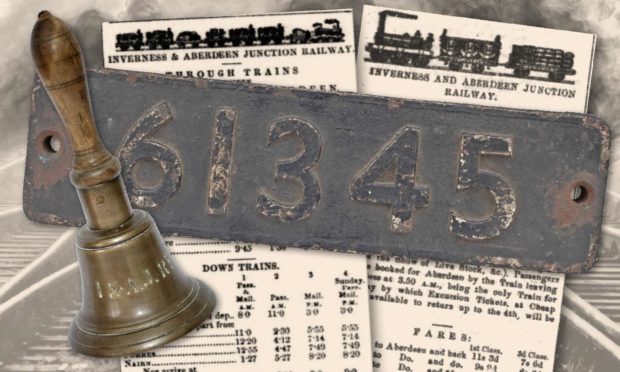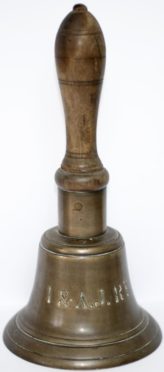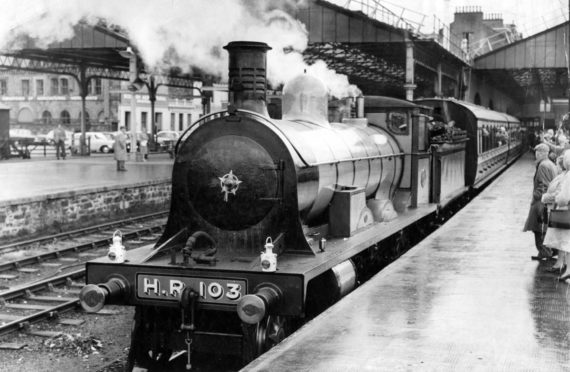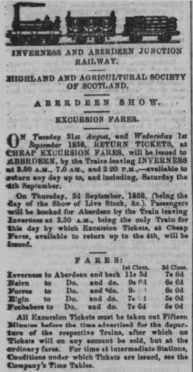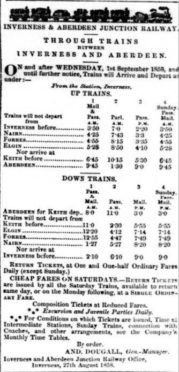A rare station bell dating from the launch of the first railway line linking Aberdeen and Inverness is to go under the hammer at auction.
It is one of two items of surviving Aberdeen-related railway memorabilia that is to be auctioned this month.
At almost 165-years-old, the hand bell is thought to be a rare survivor from the early days of railway mania in Scotland.
The unusual piece of railwayana dates from 1857 – the year the Inverness and Aberdeen Junction Railway launched, uniting the Granite City with the Highland capital.
The brass bell is engraved with the railway company initials I & A. J. RY and stands at 12 inches tall.
And it’s predicted the item could go for hundreds of pounds with opening offers invited at £600 when it goes under the hammer on July 23 with GW Railwayana Auctions.
The rare bell would have belonged to one of the stations along the line between Forres and Inverness where the line opened in 1857.
The route later joined the existing Great North of Scotland Railway (GNSR) at Keith to create a direct link to Aberdeen.
gh
Another interesting piece of Aberdeen’s railway history is due to appear at the same auction – a smokebox number plate from a long-scrapped locomotive.
The number plate 61345 belonged to a former London and North Eastern Railway (LNER) Thompson B1 4-6-0 locomotive built at Gorton, Manchester, in 1949.
The Thompson B1 was designed by LNER chief engineer Edward Thompson and went on to become the most successful of his creations.
It was a mixed-traffic type engine and 410 were built by LNER and British Railways.
The B1s were good at starting, which particularly suited the hilly Scottish terrain and stations which were built on inclines.
Locomotive number 613454 was allocated to Ferryhill and Kittybrewster stations in Aberdeen, as well as 64A St Margaret’s near Edinburgh.
The B1 model was withdrawn from the network in 1961, but Aberdeen’s No. 613454 clung on for another few years.
The steam engine was a Scottish working loco for its whole life, and was withdrawn in 1966 before being scrapped the same year at GH Campbell in Airdrie.
Only one of these 410 engines has survived after being rescued from a scrapyard.
And now, any collectors of railwayana have the opportunity to own the surviving part of an Aberdeen engine – and part of railway heritage consigned to the history books and scrap yards.
Bids of £480 are being invited for the piece of unique railway memorabilia.
When railway mania reached Inverness
During the 1840s, there was huge interest in the investment of railways, and shares in prospective lines boomed.
Railway mania had begun.
Previously it was only the ultra-wealthy that could afford to invest in big business, but the Industrial Revolution created a new middle class with savings to spend.
The government encouraged spending, and the advent of new railway lines was largely unregulated.
Anyone with money could invest in shares and subscriptions – and anyone could establish a company and submit a bill to Parliament seeking the right to purchase land for the line.
Many MPs were investors and it was not often that a line was turned down.
Although with the boom came the bust and many companies folded or were found to be fraudulent.
The desire to link the Nairn and Inverness Railway with the GNSR line at Aberdeen was first mooted in the 1850s.
And by 1855, the wheels were in motion, negotiations were taking place between the two companies with an agreement to extend each of their operations to Keith.
In December 1855, the new Inverness and Aberdeen Junction Railway, chaired by the Earl of Seafield, updated the public of their plans.
Seeking funding, the promoters said: “The complete railway communication from Aberdeen to Inverness will be secured with the least possible delay, if the promoters receive that degree of support from the public.”
Potential investors were told the line would not exceed the cost of £8,000 per mile, with 41 miles needed to link the two companies’ existing lines’ terminus at Keith and Nairn.
And more importantly, they were assured their investment would bring reward.
The bill passed through Parliament in 1856 and labourers got to work in 1857.
By August 1858 the full line between Inverness and Keith was open, linking Aberdeen and the Highlands.
See more like this:
